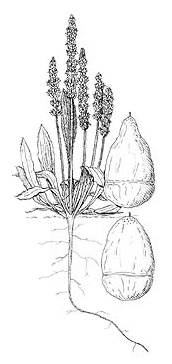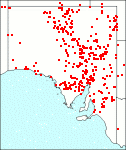Family: Plantaginaceae
Plantago drummondii
Citation:
Decne. in A. DC., Prod. 13, 1:701 (1852).
Synonymy: Not Applicable Common name: Sago weed, dark sago weed.
Description:
Annuals with leaves in a basal rosette, with a wiry or sometimes woody tap root up to 5 mm thick in large specimens; leaves rarely with an indistinct petiole up to 3 cm long continued into a long cuneate base, oblanceolate rarely linear-oblanceolate, 2-17 x 0.3-2.5 cm, acute to obtuse, entire or with widely spaced teeth or serrations, with 3 rarely only 1 main vein, villous to pubescent.
Spikes loosely cylindrical, 1.5-15 cm, becoming less compact when fruiting; peduncle 2-18 cm long, terete, villous to pubescent, with lower flowers borne at the level of or just above the leaf apices; bracts broadly elliptic to ovate, as long as or shorter than the sepals, with broad membranous margins; sepals elliptic-oblong, 2-3.5 mm long, subequal, glabrous or a hairy central ridge (dark-brown when dried) with a broad membranous margin; corolla tube 2.5-3.5 mm long; lobes ovate to broadly ovate, 1.5-2.5 mm long, often acuminate; anthers broadly ovate, 0.8-1.5 mm long; ovary 2- or 3-celled with 2 ovules in the lower ones and a single one in the upper cell.
Capsule pyriform to almost broadly ellipsoid, 3-5 mm long, 2.5-3 mm diam., usually dark-brown; seeds 1-5, 2-3 mm long, narrowly compressed-ellipsoid, pale- to dark-brown.

| Habit and variation of fruit.
|
Image source: fig. 614F in Jessop J.P. & Toelken H.R. (Ed.) 1986. Flora of South Australia (4th edn).
|
Published illustration:
Cunningham et al. (1982) Plants of western New South Wales, p. 618.
|
|
Distribution:
|
Common in arid areas on a wide range of soils and habitats.
S.Aust.: NW, LE, NU, GT, FR, EA, EP, MU, SL. W.Aust.; N.T.; Qld; N.S.W.; Vic.
|
Conservation status:
native
Flowering time: July — Sept.
|

SA Distribution Map based
on current data relating to
specimens held in the
State Herbarium of South Australia
|
Biology:
The large dark-brown capsules of this species usually distinguish depauperate forms from any of the other annual species, e.g. P. sp. B.
Author:
Not yet available
|

